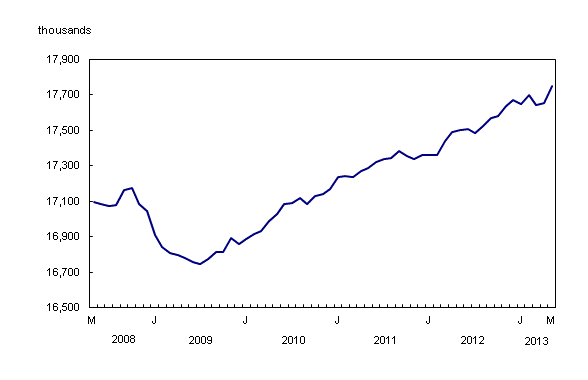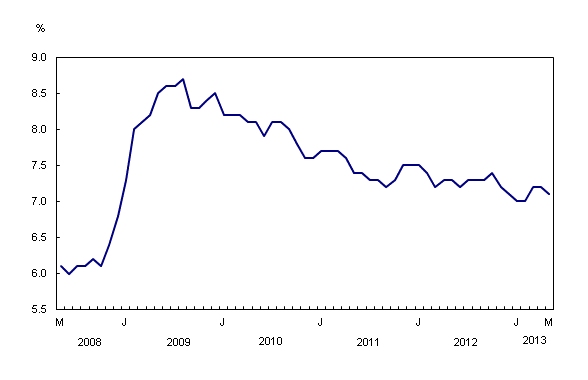Labour Force Survey, May 2013
Archived Content
Information identified as archived is provided for reference, research or recordkeeping purposes. It is not subject to the Government of Canada Web Standards and has not been altered or updated since it was archived. Please "contact us" to request a format other than those available.
Released: 2013-06-07
Following little change the previous month, employment rose by 95,000 in May, with most of the increase in full-time work. This employment gain pushed the unemployment rate down 0.1 percentage points to 7.1%.
Compared with 12 months earlier, employment grew 1.4% or 250,000, all in full-time work. Over the same period, the total number of hours worked rose 1.1%.
In May, employment increased in Ontario, Quebec, Alberta, New Brunswick and Manitoba, while it declined in Prince Edward Island.
Employment rose in construction; retail and wholesale trade; "other services;" and business, building and other support services.
All of the employment gains in May were among private sector employees, offsetting losses over the previous two months for this group.
Employment in May increased among youths and people aged 55 and over, while it was little changed for those aged 25 to 54.
Employment gains in several provinces
In May, employment in Ontario increased by 51,000, with large gains in full-time work partly offset by losses in part-time work. With this gain, the unemployment rate fell 0.4 percentage points to 7.3%, the lowest since November 2008. Year-over-year growth was 2.0%, higher than the national average of 1.4%.
Employment in Quebec rose by 20,000 in May, offsetting declines earlier in the year. The unemployment rate was 7.7%. Compared with 12 months earlier, employment was up 1.3%.
In Alberta, employment increased for the second consecutive month, up 19,000 in May. Despite this gain, the unemployment rate for the province was up 0.4 percentage points to 4.8% as more people participated in the labour force. On a year-over-year basis, employment growth in this province was 2.3%, all in full-time work.
The number of workers in New Brunswick rose by 3,700 in May, offsetting the decline in April. The unemployment rate for the province was 10.5% in May. Compared with 12 months earlier, employment was down 1.3%.
Following a decline the previous month, employment in Manitoba increased by 3,000 in May and the unemployment rate was 5.7%. On a year-over-year basis, employment was little changed.
In Saskatchewan, employment was little changed for the fourth consecutive month. Nevertheless, year-over-year growth was 2.9%, well above the national average.
Large gains in construction in May
Following two months of little change, construction rose by 43,000 in May. With this gain, construction was up 5.8% or 74,000 from 12 months earlier.
In May, employment in retail and wholesale trade increased by 27,000. Over the previous 12 months, employment in this industry rose 3.1% or 83,000.
Employment in "other services," such as repair and maintenance or private household services, increased by 22,000 in May. Despite this month's gain, employment remained below its level from 12 months earlier, down 5.5% or 45,000.
The number of workers in business, building and other support services rose by 21,000 in May. Compared with 12 months earlier, employment in this industry was up 5.6% or 38,000.
Employment rose by 95,000 among private sector employees in May, and was little changed for public sector employees and the self-employed. Compared with 12 months earlier, the number of private sector employees increased 1.1% or 123,000. Public sector employment was up 2.6% or 92,000, mainly from gains in health care and social assistance. Self-employment was little changed over this 12-month period.
Employment up among youths and people aged 55 and over
In May, employment was up 54,000 among youths aged 15 to 24, with gains in Ontario, Quebec, and Alberta. This increase pushed their unemployment rate down 0.9 percentage points to 13.6%. With the employment increase in May, year-over-year gains for this age group totalled 48,000 (+2.0%).
Following two months of little change, employment among people aged 55 and over rose by 34,000 in May, with gains for both men and women, pushing the unemployment rate for this age group down 0.3 percentage points to 5.8%. Over the previous 12 months, employment increased 142,000 (+4.4%), mostly a result of population ageing.
Among people aged 25 to 54, employment was little changed in May. Compared with 12 months earlier, employment for people in this age group was up 60,000 (+0.5%).
Student summer employment
From May to August, the Labour Force Survey collects labour market data about young people aged 15 to 24 who were attending school full time in March and who intend to return to school full time in the fall. The May survey results provide the first indicators of the summer job market, especially for students aged 20 to 24, as many students aged 15 to 19 are not yet out of school for the summer. The data for June, July and August will provide further insight into the summer job market. The published data are not seasonally adjusted, and therefore comparisons can only be made from one year to another.
The rate of employment among returning students aged 20 to 24, that is, the number of employed as a percentage of their population, was 59.9% in May, similar to that of 12 months earlier. Their unemployment rate was 15.5% in May, little changed from a year earlier.
Note to readers
The Labour Force Survey (LFS) estimates are based on a sample and are therefore subject to sampling variability. As a result, monthly estimates will show more variability than trends observed over longer time periods. Estimates for smaller geographic areas or industries also have more variability. For an explanation of sampling variability of estimates and how to use standard errors to assess this variability, consult the "Estimates quality" section of the publication Labour Force Information (Catalogue number71-001-X).
The employment rate is the number of employed persons as a percentage of the population 15 years of age and over. The rate for a particular group (for example, youth aged 15 to 24) is the number employed in that group as a percentage of the population for that group.
The unemployment rate is the number unemployed as a percentage of the labour force (employed and unemployed).
The participation rate is the number of employed and unemployed as a percentage of the population. For more detailed information, see the Guide to the Labour Force Survey (Catalogue number71-543-G).
Unless otherwise stated, this release presents seasonally adjusted estimates, which facilitates comparisons by removing the effects of seasonal variations. For more information on seasonal adjustment, see Seasonal adjustment and identifying economic trends.
Each year, the LFS revises its estimates for the previous three years, using the latest seasonal factors.
A more detailed summary, Labour Force Information (Catalogue number71-001-X), is now available online for the week ending May 18. From the Browse by key resource module of our website under Publications, choose All subjects, then Labour.
Data tables are also now available online. From the Browse by subject module of our website, choose Labour.
The next release of the Labour Force Survey will be on July 5.
Contact information
For more information, contact us (toll-free 1-800-263-1136; infostats@statcan.gc.ca).
To enquire about the concepts, methods or data quality of this release, contact Vincent Ferrao (613-951-4750; vincent.ferrao@statcan.gc.ca) or Jason Gilmore (613-951-7118; jason.gilmore@statcan.gc.ca), Labour Statistics Division.
- Date modified:



